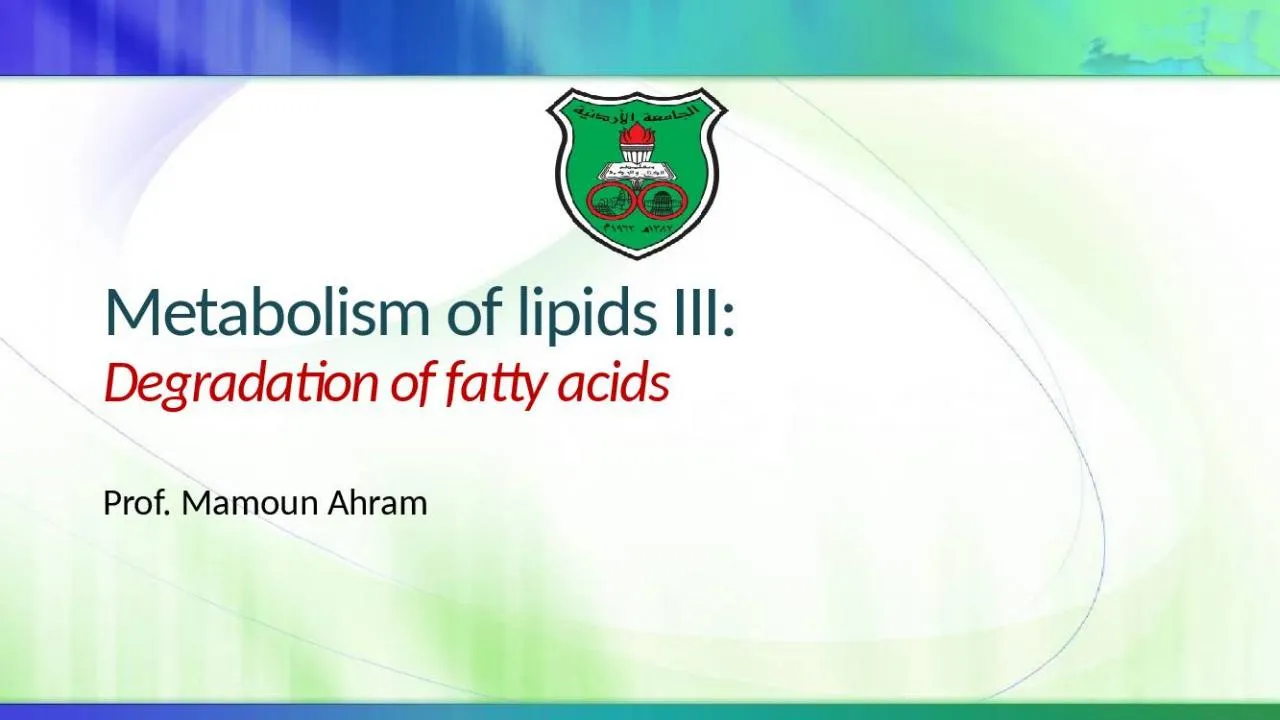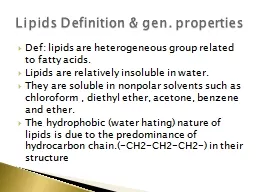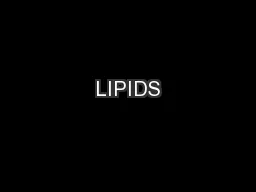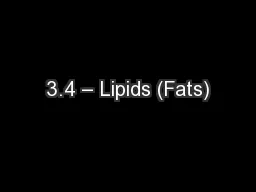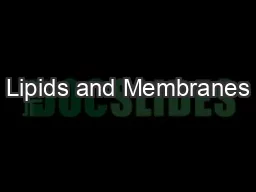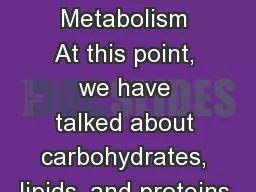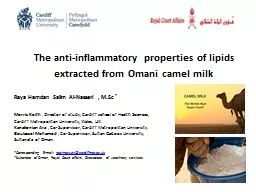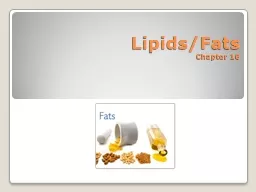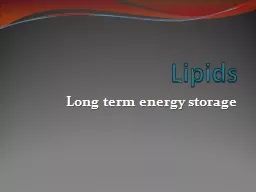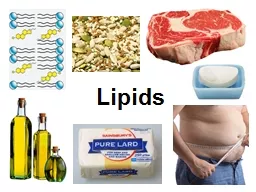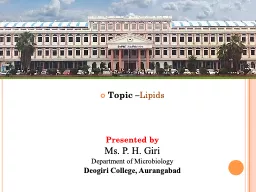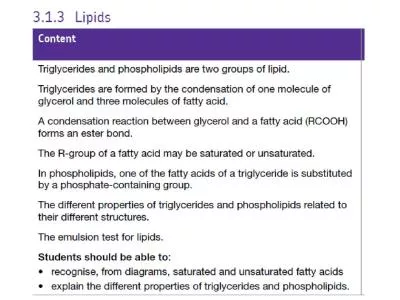PPT-Metabolism of lipids III
Author : delcy | Published Date : 2022-02-12
Degradation of fatty acids Prof Mamoun Ahram Resources This lecture Lippincotts Biochemistry Ch 16 Lipids and energy TAGs are the bodys major fuel storage reserve
Presentation Embed Code
Download Presentation
Download Presentation The PPT/PDF document "Metabolism of lipids III" is the property of its rightful owner. Permission is granted to download and print the materials on this website for personal, non-commercial use only, and to display it on your personal computer provided you do not modify the materials and that you retain all copyright notices contained in the materials. By downloading content from our website, you accept the terms of this agreement.
Metabolism of lipids III: Transcript
Degradation of fatty acids Prof Mamoun Ahram Resources This lecture Lippincotts Biochemistry Ch 16 Lipids and energy TAGs are the bodys major fuel storage reserve The complete oxidation of fatty acids to CO2 and H2O generates 9 kcalg fat as compared to 4 kcalg protein or carbohydrate Why. Chapter 29. 2. Lipids. are . biomolecules. that are soluble in organic solvents.. The identity of lipids is defined on the basis of a physical property and not by the presence of a particular functional group.. Lipids are relatively insoluble in water.. They are soluble in . nonpolar. solvents such as chloroform , diethyl ether, acetone, benzene and ether.. The hydrophobic (water hating) nature of lipids is due to the predominance of hydrocarbon chain.(-CH2-CH2-CH2-) in their structure. 3.4 What Are Lipids?. Lipids. are a diverse group of molecules that contain regions composed almost entirely of hydrogen and carbon. All lipids contain large chains of nonpolar hydrocarbons. Most lipids are therefore hydrophobic and water insoluble. Learning Objectives. Learn what a triglyceride is.. Learn what a fatty acid is.. Learn the structure of a . phospholipid. .. Learn how lipids are tested for.. What is a lipid?. Like most other biochemical substances, lipids contain . Pratt & . Cornely. , . Ch. 8. Lipids and Membranes. There is a lot of important biochemistry of lipids.. We won’t cover it all!. The key points for this class have to do with their role in membranes and fat metabolism. Pratt & . Cornely. , . Ch. 8. Lipids and Membranes. There is a lot of important biochemistry of lipids.. We won’t cover it all!. The key points for this class have to do with their role in membranes and fat . CHAPTER 10. UNIT. TARGETS. DESCRIBE THE MOLECULAR STRUCTURE 3 types of lipids: GLYCERIDES, PHOSHOLIPIDS, AND STEROLS. DEFINE SATURATED, MONOSATURATED AND POLYUNSATURATED FATTY ACIDS.. LIST CATEGORIES OF LIPIDS BASED ON PHYSICAL STATE AND DIETARY SOURCES. We have touched on their metabolism.. Now we will wrap that up a bit by describing once you have digested carbohydrates, lipids, and proteins, what does your body do with it.. Metabolism. Metabolism:. The anti-inflammatory properties of lipids extracted from Omani camel milk Raya Hamdan Salim Al-Nasseri , M.Sc * Morris Keith , Director of study, Cardiff school of Health Sciences, Cardiff Metropolitan University, Wales, UK. Lipids are a family of chemical compounds that are a main component in every living cell. They include the following three categories:. Triglycerides. – they include all fats and oils people typically eat.. What elements are Lipids composed of?. Carbon (C) . Hydrogen (H). Oxygen (O). A whole lot of Hydrogen!!!!!. Function in Living Organisms. Lipids usually serve one of three functions: . 1. Energy storage. Cholesterol. Rich in hydrocarbon. Polar group (usually small). Oleic acid. Lipids serve a wide variety of functions. Vitamin K. Surfactants. Protection. Membrane. components. Insulation. Energy storage. by. Ms. . P. . . H. . Giri. Department of Microbiology. Deogiri . College, Aurangabad. B.Sc. F. Y.. Semester II. Paper No. V. Basic Biochemistry. Unit 2 Lipids. Ms. . Priyanka. H. . Giri. Lipids:. Lipids are . are a diverse group of compounds that are insoluble in water but soluble in organic solvents such as ethanol.. The most common types of lipid are . triglycerides. (sometimes known as true fats or neutral fats), but other important lipids include waxes, steroids and cholesterol..
Download Document
Here is the link to download the presentation.
"Metabolism of lipids III"The content belongs to its owner. You may download and print it for personal use, without modification, and keep all copyright notices. By downloading, you agree to these terms.
Related Documents

